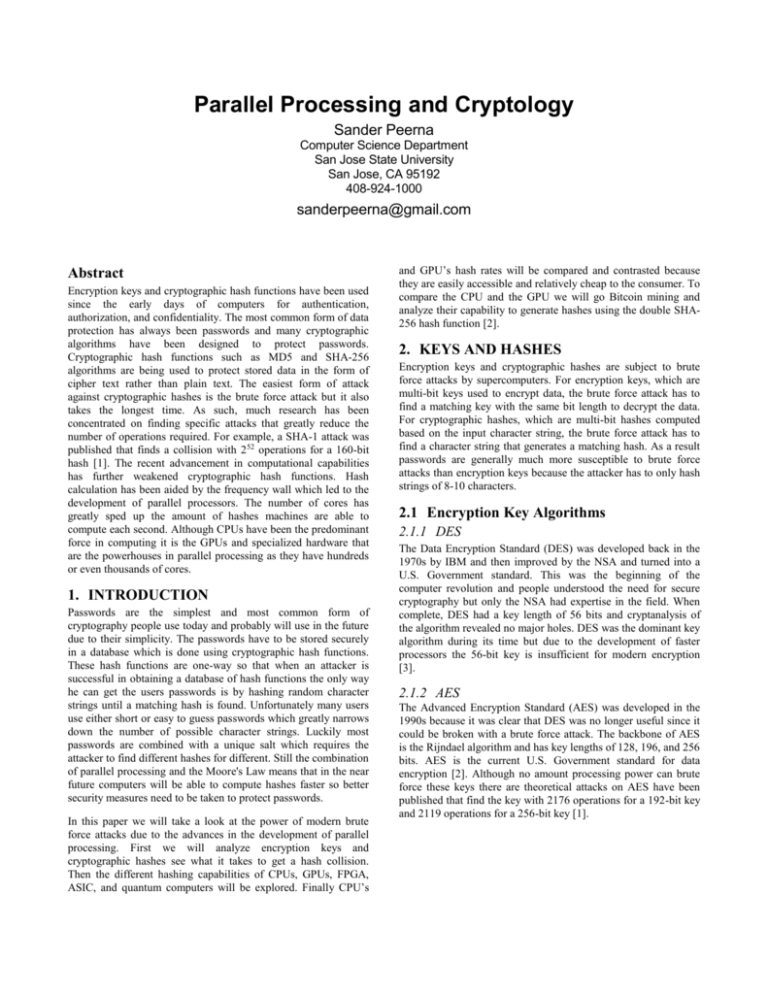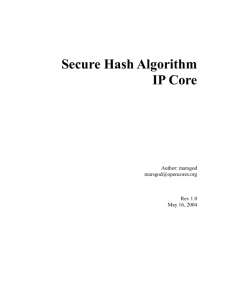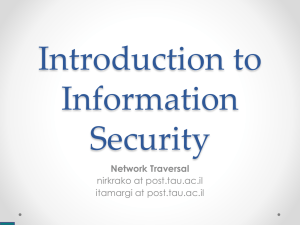2. keys and hashes - San Jose State University
advertisement

Parallel Processing and Cryptology Sander Peerna Computer Science Department San Jose State University San Jose, CA 95192 408-924-1000 sanderpeerna@gmail.com Abstract Encryption keys and cryptographic hash functions have been used since the early days of computers for authentication, authorization, and confidentiality. The most common form of data protection has always been passwords and many cryptographic algorithms have been designed to protect passwords. Cryptographic hash functions such as MD5 and SHA-256 algorithms are being used to protect stored data in the form of cipher text rather than plain text. The easiest form of attack against cryptographic hashes is the brute force attack but it also takes the longest time. As such, much research has been concentrated on finding specific attacks that greatly reduce the number of operations required. For example, a SHA-1 attack was published that finds a collision with 2 52 operations for a 160-bit hash [1]. The recent advancement in computational capabilities has further weakened cryptographic hash functions. Hash calculation has been aided by the frequency wall which led to the development of parallel processors. The number of cores has greatly sped up the amount of hashes machines are able to compute each second. Although CPUs have been the predominant force in computing it is the GPUs and specialized hardware that are the powerhouses in parallel processing as they have hundreds or even thousands of cores. 1. INTRODUCTION Passwords are the simplest and most common form of cryptography people use today and probably will use in the future due to their simplicity. The passwords have to be stored securely in a database which is done using cryptographic hash functions. These hash functions are one-way so that when an attacker is successful in obtaining a database of hash functions the only way he can get the users passwords is by hashing random character strings until a matching hash is found. Unfortunately many users use either short or easy to guess passwords which greatly narrows down the number of possible character strings. Luckily most passwords are combined with a unique salt which requires the attacker to find different hashes for different. Still the combination of parallel processing and the Moore's Law means that in the near future computers will be able to compute hashes faster so better security measures need to be taken to protect passwords. In this paper we will take a look at the power of modern brute force attacks due to the advances in the development of parallel processing. First we will analyze encryption keys and cryptographic hashes see what it takes to get a hash collision. Then the different hashing capabilities of CPUs, GPUs, FPGA, ASIC, and quantum computers will be explored. Finally CPU’s and GPU’s hash rates will be compared and contrasted because they are easily accessible and relatively cheap to the consumer. To compare the CPU and the GPU we will go Bitcoin mining and analyze their capability to generate hashes using the double SHA256 hash function [2]. 2. KEYS AND HASHES Encryption keys and cryptographic hashes are subject to brute force attacks by supercomputers. For encryption keys, which are multi-bit keys used to encrypt data, the brute force attack has to find a matching key with the same bit length to decrypt the data. For cryptographic hashes, which are multi-bit hashes computed based on the input character string, the brute force attack has to find a character string that generates a matching hash. As a result passwords are generally much more susceptible to brute force attacks than encryption keys because the attacker has to only hash strings of 8-10 characters. 2.1 Encryption Key Algorithms 2.1.1 DES The Data Encryption Standard (DES) was developed back in the 1970s by IBM and then improved by the NSA and turned into a U.S. Government standard. This was the beginning of the computer revolution and people understood the need for secure cryptography but only the NSA had expertise in the field. When complete, DES had a key length of 56 bits and cryptanalysis of the algorithm revealed no major holes. DES was the dominant key algorithm during its time but due to the development of faster processors the 56-bit key is insufficient for modern encryption [3]. 2.1.2 AES The Advanced Encryption Standard (AES) was developed in the 1990s because it was clear that DES was no longer useful since it could be broken with a brute force attack. The backbone of AES is the Rijndael algorithm and has key lengths of 128, 196, and 256 bits. AES is the current U.S. Government standard for data encryption [2]. Although no amount processing power can brute force these keys there are theoretical attacks on AES have been published that find the key with 2176 operations for a 192-bit key and 2119 operations for a 256-bit key [1]. Table 1. The total possible combinations for different key sizes and their average time to crack [4]. In the following sections the hardware capable of such calculations will be explored. 3.1 CPU Modern Central Processing Units (CPU) can have up to 12 cores which help run multiple tasks at the same time. For the purpose of calculating keys and hashes CPUs are at the bottom of the food chain. CPUs are made to run entire programs following their instructions and constantly making decisions. As an analogy, CPUs are the executives of a machine because they have to manage the execution of programs [11]. 3.2 GPU 2.2 Cryptographic Hash Functions An easier and more common implementation of cryptography is hash functions such as MD5 and SHA-2. As previously mentioned, the hash functions are the basis for how user data, such as passwords, are stored securely in a database. Hash functions are functions that convert plain text into a new string of characters with a specified length. For example [5], Following the previous analogy, Graphical Processing Units (GPU) are the laborers of a machine because they are good at specific tasks. Their purpose is to do a lot of repetitive work thus they are also made up of hundreds and even thousands of cores. All these cores work together running a single instruction on multiple data. Since computing hashes is a repetitive task it can be seen that GPUs are vastly superior to CPUs in terms of the amount of hashes they are able to computer per second [11]. sander -> 88a1092514f5fca17d8aca0751c2a3978495d731c3a7a5d6b7ebf5 3e2ba0f1a2. 3.3 FPGA These functions are one-way and unique to each string so that an attacker can’t easily reverse the hash string. An attacker can only break the hash by figuring out the original string that was used. As a result an attacker has to use brute force to find a collision. Depending on the character pool of the string differing amount of time are required to brute force the hashes. At around 9 characters is where brute forcing gets difficult and requires specialized hardware [6]. Field-Programmable Gate Arrays (FPGA) are the next level in repetitive parallel processing tasks. FPGAs are fully programmable and extremely fast at specific tasks due to the configurable logic blocks that are wired together with interconnects and switches and a small amount of memory. Although FPGAs have much lower clock speeds than CPUs and GPUs, they are able to generate hashes much faster using less power because they don’t need to queue up instructions and can execute multiple at a time [12]. Figure 2. Password recovery comparison of CPUs, GPUs, and FPGAs [12]. Figure 1. The time consumed for cracking MD5 hashes with different password lengths, character sets, and programs [7] [8] [9] [10]. 3. HARDWARE Different types of hardware can be used for generating keys and hashes including specialized hardware that are made for these repetitive tasks as well as future hardware that is in development. 3.4 ASIC Application-Specific Integrated Circuits are microchips that have been built for a specific purpose like FPGAs. The major difference between the two hardware types is that ASICs are not reprogrammable and have a higher density of gates. As a result ASICs are faster at calculating hashes while using less power [13]. 3.5 Quantum Computers Quantum computers will have enormous implications on cryptography when researchers are able to build a working version. Quantum computers are based on “quantum superposition,” meaning that object simultaneously exist in all states. Current computers use binary bits that are either zero or one but a quantum computer uses qubits that are simultaneously zero and one. This allows the quantum computer to avoid having to make calculations reducing the steps an algorithm must take in performing some computation. This means that many of the strongest encryptions that are used today can be easily broken such as RSA [14]. For a current computer, brute forcing through 2128 keys takes on average 2127 steps. On the other hand, a quantum computer takes steps proportional to the square root of that number so brute forcing would take 264 steps. This means that a 128 bit key will be easily breakable, 192 bit key is safe to an extent, and a 256 bit key is completely safe [15]. Table 2. The CPU hash rate increases linearly to the number of cores used. 4. EXPERIMENT & RESULTS The purpose of the experiment is to show the hashing capabilities of the CPU and the GPU. The two will be tested using Bitcoin mining programs that are freely available on the internet. Bitcoin mining programs were chosen for this experiment because they are designed to calculate hashes as fast as possible. Furthermore the hash algorithm used by Bitcoin is the double SHA-256 cryptographic hash. The scenario for Bitcoin mining is very similar to brute forcing hashes. 4.1.2 GPU 4.1 Experiment cgminer -o us1.eclipsemc.com:3333 -u wallet -p x -I 9 An Intel® Core™ i5-3570K Processor [16] will be used along with CPUMiner version 2.3.3 [17] to calculate the hashing capabilities of the CPU. An AMD Radeon™ HD 7870 [18] will be used along with CGMiner version 3.7.2 [19] to calculate the hashing capabilities of the GPU. Each miner was run for 5 minutes on a Window 8.1 machine to get the average millions of hashes per second (Mh/s). The GPU tested had 1280 stream processors to run simple, repetitive instructions. The hash rate of the GPU was calculated using two different GPU clock speeds. The first round of testing was run with a clock speed of 1000 MHz. For the second round the GPU was overclocked to 1200 MHz and the same tests were run again. The following command was run in the Windows command prompt: Table 3. The GPU hash rate increases proportionally to the clock speed. 4.1.1 CPU The CPU tested had 4 cores with 1 thread per core. The hash rate of the CPU was calculated using increased number of cores from 1-4. The following command was run in the Windows command prompt with different values for the ‘--threads’ option: minerd.exe --threads 4 -o stratum+tcp://us1.eclipsemc.com:3333 -u worker -p changeme -a sha256d -R 2 4.2 Results As can be seen from the above figures the GPU greatly outperformed the CPU. This was the expected result as the GPU has far more simple cores for instructions while the CPU only has a few complex cores. This means that the GPU is superior for brute force attacks because they are able to compute more hashes and have lower power consumption. Based on knowledge of FPGA and ASIC hardware it can be concluded that they will outperform the GPU in hash calculations. [10] Svarichevsky, Mikhail. "World Fastest MD5 Cracker 5. CONCLUSION Keys and hashes are an important part of authentication, authorization, and confidentiality. As computer hardware has become more powerful over the years tougher security measures have been implemented due to the possibility of brute force attacks. It has been shown that with modern hardware brute forcing passwords with less than 9 characters is relatively simple while anything over 10 characters is impossible. Future quantum computers will require all new secure cryptographic keys and hashes for data protection. 6. REFERENCES [1] "Parallel Crypto." Parallel Crypto. 3 Sept. 2013. Web. <http://www.cs.rit.edu/~ark/parallelcrypto/>. [2] "Protocol Specification." Bitcoin. 13 Apr. 2014. Web. <https://en.bitcoin.it/wiki/Protocol_specification#Hashes>. [3] Stamp, Mark. "Symmetric Key Crypto." Information Security: Principles and Practice. Hoboken: John Wiley & Sons, 2011. 58-69. [4] Arora, Mohit. "How Secure Is AES against Brute Force Attacks? | EE Times." EETimes. 5 July 2012. Web. <http://www.eetimes.com/document.asp?doc_id=1279619>. [5] XORBIN. "SHA-256 Hash Calculator." Web. <http://www.xorbin.com/tools/sha256-hash-calculator>. [6] Vu, Anh-Duy, Jean-Il Han, Hong-An Nguyen, Young-Man Kim, and Eun-Jin Im. "A Homogeneous Parallel Brute Force Cracking Algorithm on the GPU." Seoul. ICT Convergence (ICTC) 30 Sept. 2012: 561-64. IEEE. Web. [7] System and Security Software from ElcomSoft. Web. <http://www.elcomsoft.com/download.html>. [8] InsidePro Software. "Extreme GPU Bruteforcer." Extreme GPU Bruteforcer. Web. <http://www.insidepro.com/eng/egb.shtml>. [9] Golubev, Ivan. "IGHASHGPU." Ivan Golubevs RSS. Web. <http://www.golubev.com/hashgpu.htm>. BarsWF." Web. <http://3.14.by/en/md5>. [11] "Why a GPU Mines Faster than a CPU." Bitcoin. 8 Jan. 2013. Web. <https://en.bitcoin.it/wiki/Why_a_GPU_mines_faster_than_a _CPU>. [12] Verry, Tim. "Are FPGAs the Future of Password Cracking and Supercomputing?" ExtremeTech. 20 July 2012. Web. <http://www.extremetech.com/computing/133110-are-fpgasthe-future-of-password-cracking-and-supercomputing>. [13] "FPGA or ASIC? Pro's & Con's of Each Technology." FPGA or ASIC? Pro's & Con's of Each Technology - Brocade Community. 29 Mar. 2013. Web. <http://community.brocade.com/t5/Service-Providers/FPGAor-ASIC-Pro-s-amp-Con-s-of-Each-Technology/ba-p/709>. [14] Rich, Steven. "NSA Seeks to Build Quantum Computer That Could Crack Most Types of Encryption." The Washington Post. The Washington Post. Web. <http://www.washingtonpost.com/world/nationalsecurity/nsa-seeks-to-build-quantum-computer-that-couldcrack-most-types-of-encryption/2014/01/02/8fff297e-719511e3-8def-a33011492df2_print.html>. [15] AgileBits. "Guess Why We're Moving to 256-bit AES Keys." Agile Blog. 9 Mar. 2013. Web. <http://blog.agilebits.com/2013/03/09/guess-why-weremoving-to-256-bit-aes-keys/>. [16] Intel. "Intel® Core I5-3570K Processor." Web. <http://ark.intel.com/products/65520/Intel-Core-i5-3570KProcessor-6M-Cache-up-to-3_80-GHz>. [17] "Pooler/cpuminer." GitHub. Web. <https://github.com/pooler/cpuminer>. [18] AMD. "AMD Radeon™ HD 7800 Series Graphics Cards." Web. <http://www.amd.com/enus/products/graphics/desktop/7000/7800>. [19] "Ckolivas/cgminer." GitHub. Web. <https://github.com/ckolivas/cgminer>.







